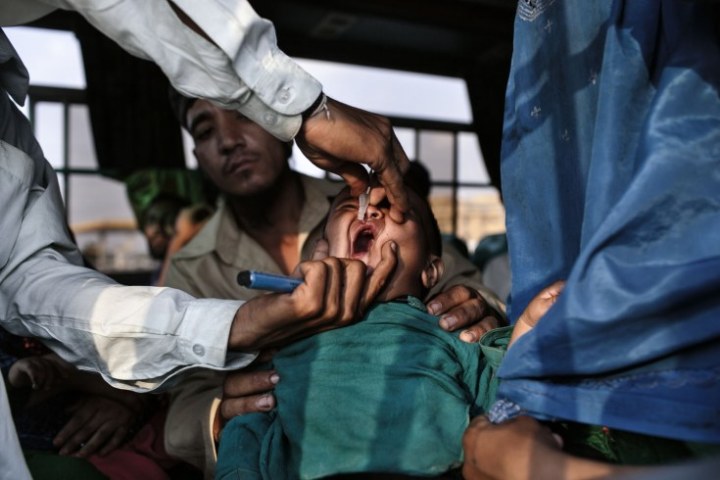Автор: TIME
A child getting a polio vaccine at Toll Plaza, outskirts of Karachi. Polio is a highly infectious disease caused by a virus that can provoke permanent paralysis in a matter of hours. There is no cure, but there are safe and effective vaccines.
There’s no one place a virus goes to die — but that doesn’t make its demise any less a public health victory. Throughout human history, viral diseases have had their way with us, and for just as long, we have hunted them down and done our best to wipe them out. In the developed world, vaccines have made once-common scourges such as measles, rubella, mumps and whooping cough rare to the point of near-extinction. Only once, however, has any virus been flushed from its last redoubts in both the body and the wild and effectively vaccinated out of existence. That virus was smallpox, which ceased to exist outside high-security labs in 1977. Since that day, humanity has been free to put the vaccines against the disease — and the terror its periodic outbreaks would cause — on the shelf forever.
Now we are tantalizingly close to another such epic moment. This time the disease in the medical cross hairs is polio, and there’s no minimizing the progress made against it. Just 25 years ago, polio was endemic to 125 countries and would paralyze or kill up to 350,000 people — the overwhelming majority of them children — each year. Now the disease has been run to ground in just three countries: Afghanistan, Pakistan and Nigeria, and in 2012, it struck only 215 people worldwide. Thanks to aggressive global vaccination programs led by Rotary International, UNICEF, the World Health Organization, the U.S. Centers for Disease Control, and, most recently, the Bill and Melinda Gates Foundation, the year just beginning could be the disease’s last.
(TIME: Read the magazine story on polio, available to subscribers here)
But polio still has strong-armed friends. On January 1, as the rest of the world celebrated the New Year, gunmen in Pakistan shot and killed seven medical aid workers — six of them women or girls — who had been part of the anti-polio drive. Those killings followed nine others in December, as well as the shooting of a Ghanaian doctor, also conducting polio-vaccination work in Pakistan, in July. The month before that, the Pakistani Taliban blocked the planned vaccination of 161,000 children until U.S. drone strikes in the country were halted.
Polio is a notoriously slippery disease, one that relies on — indeed its very survival depends on — just the kind of holes such sabotage efforts open in the vaccine safety net. In 2003, polio was similarly near its end when clerics in Northern Nigeria halted inoculations — claiming that the vaccine contained HIV and was designed to sterilize children. Within two years, cases of polio linked to the Nigerian strain were raging across 16 countries. And since once case of paralysis can result for every 200 cases of polio infection, that means there may be 199 other carriers silently and unknowingly spreading the virus.
(MORE: At the U.N., a Vow to Eradicate Polio by 2015)
Using children as viral suicide bombers this way is a new — and grotesque — form of bioterrorism, and the world, for now at least, is not standing idly by. After the December killings, Pakistani officials pledged to continue with the country’s plans to deploy 250,ooo health care workers to vaccinate 35 million children this year. The governments of Nigeria and Afghanistan have similarly vowed to see the eradication drive through to its end, as have the U.N. and the other institutions involved in the battle. The Islamic Development Bank has put fresh money behind the push, donating $227 million to the vaccine program in Pakistan in particular. This is on top of the billions already provided by Rotary and the Gates Foundation alone.
All of that money could turn out to be very very well spent. One billion dollars per year over the next few years could save $50 billion over the next 20 years in the costs of continuing to chase the disease around the globe and treat the children who are felled by it. And there is no way, of course, of putting a price tag on the suffering of those stricken children — or the importance of sparing other victims the same fate. The war with the poliovirus and its human defenders has been joined — and 2013 could be the year in which the climactic battles are fought.
Polio
,
end polio


